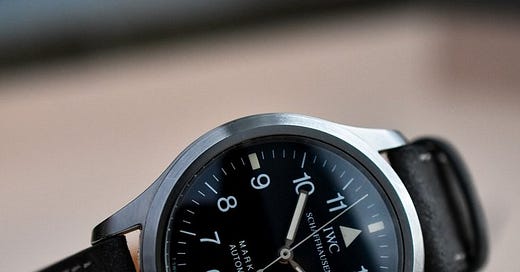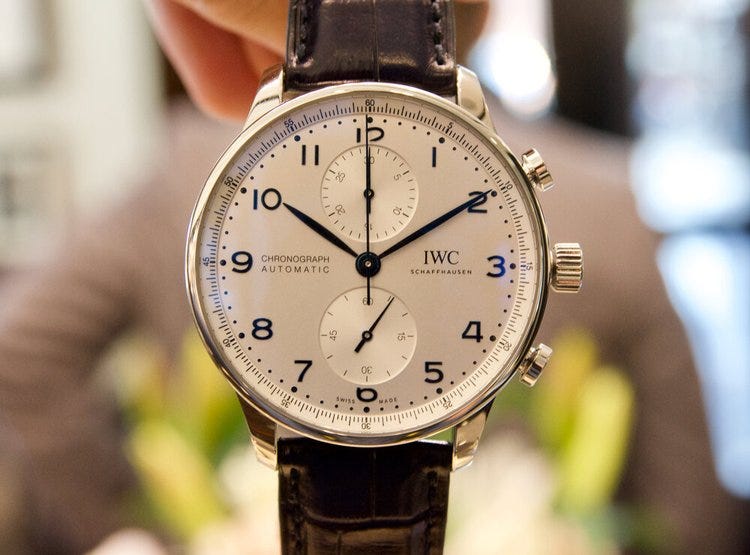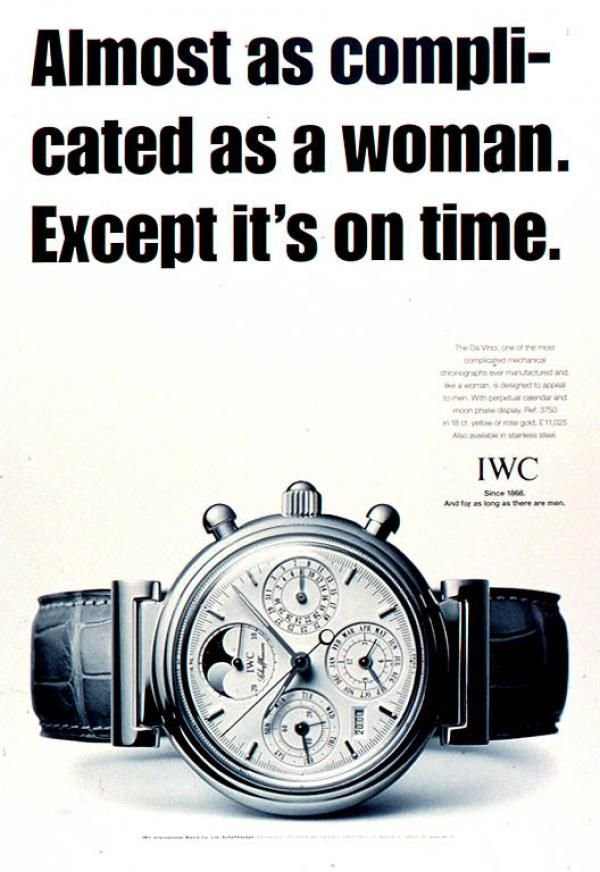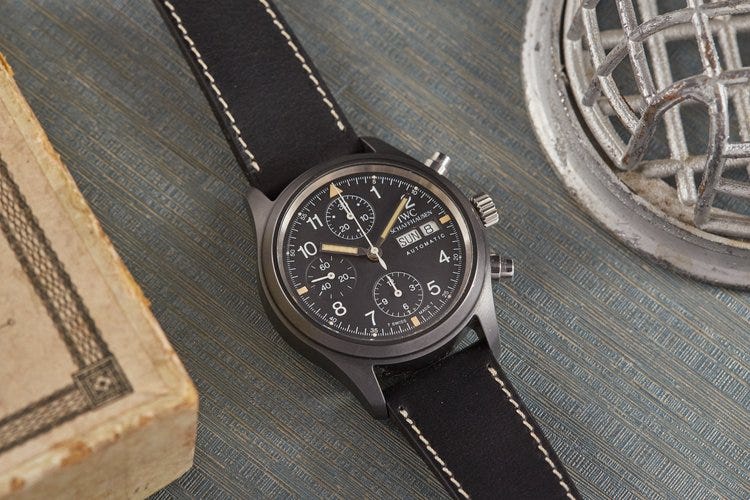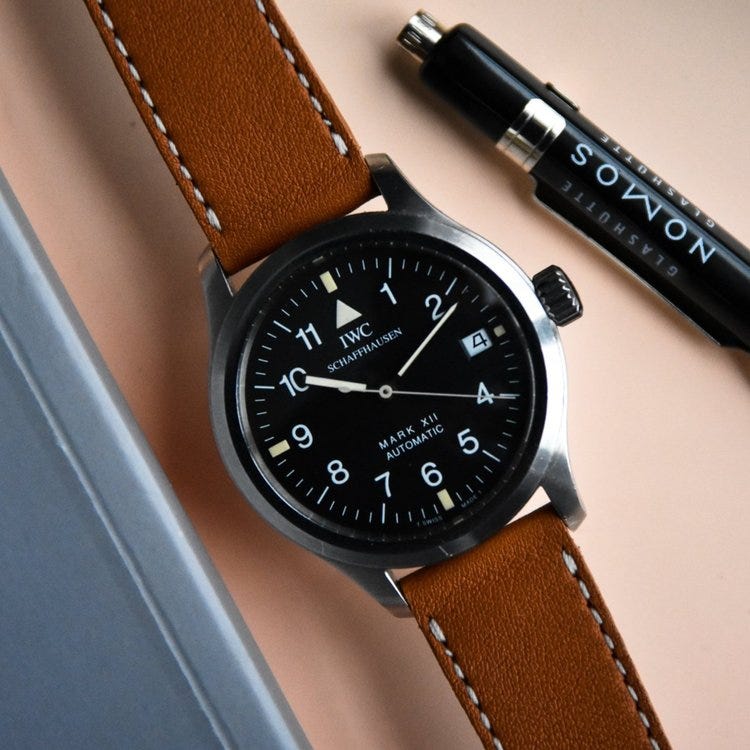This week’s newsletter is Presented By Subdial, the ultimate trading platform for true watch enthusiasts and collectors. Subdial is a real day one supporter of Rescapement, so I’m excited to be partnering more closely with them this year. Not only do they curate an amazing weekly selection of neo-vintage, independent, and pre-owned watches, they’re also heavily invested in the community and supporting quality content (if I do say so myself). Below, we’ll highlight a favorite watch from their weekly drop.
Rescapement is a weekly newsletter about watches. Subscribe now to get it in your inbox every week:
Neo-vintage and 90s nostalgia
I’ve got a long history with IWC. As I’ve written before, the Portugieser Chronograph was perhaps the first watch I ever noticed. Like, distracted-during-my-first-post-college-job-interview noticed. It didn’t look like the Timexes or Fossils I’d seen growing up, or the gaudy Rollies and Pashas I’d seen jangling on the wrists of my favorite musicians.
Eventually, I tried on a Portugieser Chronograph and realized the 40mm case with no bezel was a bit too big for me. But I started digging into the brand’s archives, vowing to find the right IWC for my wrist.
Naturally, this leads one through IWC’s heritage as a maker of military and pilot’s watches, the Mark series, and whether there’s a fit brand ambassador Lewis Hamilton can’t pull off.
Quickly, I started to stumble through 1990s IWC watches and their ad campaigns. Dutiful and woke millennial I am, I began to feel reflexively triggered by some of the taglines, retreating to ponder the societal effects of taglines like “Equality of the sexes has to stop somewhere.”
But let’s stick to watches. Advertising aside, IWC’s watchmaking absolutely thrived in the 1990s. Let’s run through a quick list of bonafides.
For the brand’s 125th anniversary in 1993, IWC created a ridiculous Grand Complication called the “Warhorse of Schaffhausen.” Based on the humble Valjoux 7750, this creation featured 22 complications (depending how you count), including a perpetual calendar designed by Kurt Klaus, a chronograph from Richard Habring, and a minute repeater from Renaud and Papi. Nowadays, these names are denizens of fine Swiss watchmaking, and here’s IWC, back in 1993, building the foundation for the entire independent era.
But IWC wasn’t done. In 1993 it also released a limited-edition Portuguese Jubilee, drawing inspiration from the (then) obscure reference 325 that was produced in extremely limited numbers in the 1930s and 40s. This laid the foundation for IWC’s signature modern line, now defined by the Portugieser Chronograph (released in 1998) that caught my eye in that fateful job interview. The Portuguese Jubilee was a large, 42mm time-only proposition, also setting the stage for the big-watch trend of the next decade.
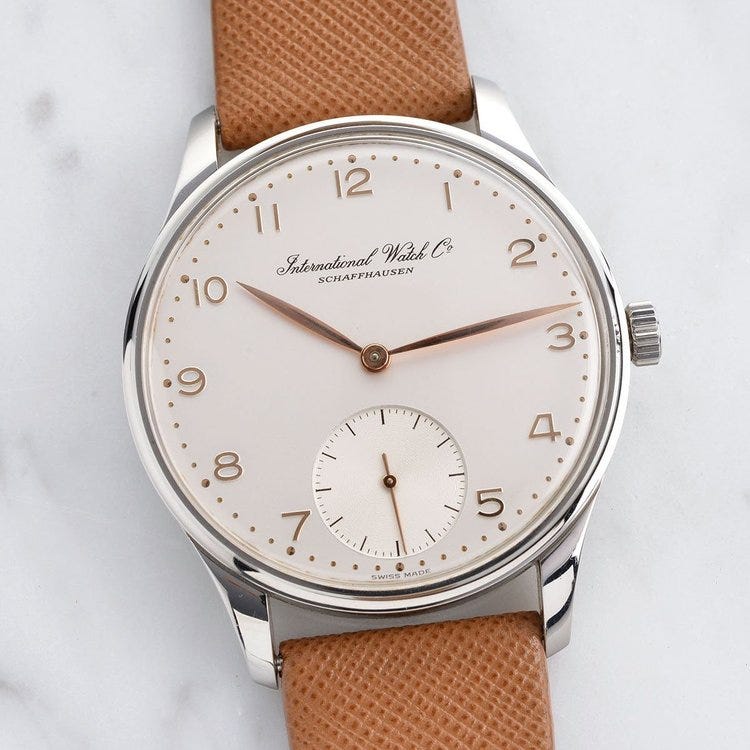
During this era, IWC was a legitimate hub of engineering and innovation for watchmaking. In the 1980s, IWC watchmaker and engineer Kurt Klaus developed a perpetual calendar module that could be fitted onto a Valjoux 7750. He believed the best path forward for Swiss watchmaking was through more accessible technical development. A few years later, watchmaker Richard Habring joined IWC. He developed a split-seconds or rattrapante chronograph (or doppelchronograph for those speaking in IWC’s native German tongue) module that could also be fitted to a Valjoux 7750. It was another innovation that made a complication typically reserved for the most hallowed halls of haute horology more accessible.
In these years, the legend Günter Blümlein led IWC. He inherited the brand, along with JLC (as part of Les Manufactures Horlogères, or LMH), in the early 1980s, when mechanical watchmaking was barely keeping its escapements ticking. Blümlein is also a legend for reviving A. Lange, a brand that he’d bring into LMH, eventually selling the holding company to Richemont.
Blümlein was the mind behind all of these developments. While many of his rivals were selling old luxury to old dudes, Blümlein decided IWC should go younger. He targeted the under-40 crowd with bold sports watches and a clear message (and those ads): IWC was different. Sure, these were expensive, mechanical watches, but they were cool.
Here’s what I love about IWC in the 1990s. In this era immediately after the quartz crisis, IWC leaned into modern manufacturing and engineering to make fine watchmaking available to the masses. That’s an attitude I can get behind.
Pilot’s watches and a birds’ eye view
Let’s take a look at a couple of these 1990s IWCs that collectors go crazy for: the ref. 3705 Ceramic Fliegerchronograph and the IWC Mark XII. Before we look at these watches though, let’s zoom out for a minute.
Back in the 1990s, most luxury watch brands were going, well, luxury. At Rolex, this meant revamping its tool watches into true luxury products: brighter lume, stronger crystals, glossier dials, and heftier cases and bracelets.
On the ad side, Rolex was trying to sell customers on the idea that “At Rolex, steel is a precious metal.”
But IWC asked “who said we want a precious watch?” An IWC is for men who “prefer to dive for their oyster and lobster,” “ride Harleys,” and had other such “typical male characteristics” (all 90s IWC ad taglines). In those days, IWC felt like the cool, anti-Rolex. Your dad wore a Daytona, you don’t want that. Even today, IWC holds onto some of this ethos.
Listen, I’ve never done any of these things — every time I see someone driving by with a Harley and no helmet I still give them a motherly tsk tsk — but I still get the message. I’ve always felt that anti-Rolex, anti-luxury ethos in my bones.
I suspect a lot of people get this. Here’s something ACL’s Michael Wililams told us once about IWC: “I like Rolex, but I was never fawning over it. There are Rolexes that I like, but even the Submariner, which is arguably the most classic watch of all time, you see it everywhere and everyone has it, so it seems too accepted. I'd rather own an IWC Pilot's watch.”
Just take a look at the Fliegerchronograph (ref. 3705) and the Mark XII. Both feature matte black dials, tritium lume, and sizes that felt more vintage than contemporary by 1990s standards (39mm and 36mm, respectively).
The Fliegerchronograph represents IWC’s innovation and experimentation with materials: It was the first mass-produced watch to feature a ceramic (zirconium oxide) case. It’s a hardcore case that’s pretty much resistant to dents and dings — on top of that, it just looks bad*ss. The Fliegerchronograph was only produced for a few years and it’s thought they made less than a couple thousand.
Meanwhile, the Mark XII was IWC’s upgrade to the classic Mark XI. It still features many of the hallmarks of the Mark XI: classic 36mm case, matte black dial with tritium lume, legible Arabic numerals and that distinct “clipped” hour hand. It even features a JLC 889/2 caliber. I mean, how good is it that IWC was still using a caliber from LMH stablemate JLC (at a time when many brands would’ve been transitioning to ETA) in what was, in effect, an entry-level time-only tool watch? It illustrates a commitment to quality from large brands that’s so rare nowadays.
This era of IWC is also often referred to as the “pre-Richemont” era. No shade to Richemont — we stan multi-national luxury conglomerates all the time here — but there’s something charming about an independent watch company doing its own thing.
The 1990s is IWC at its best. It’s the brand drawing on its decades of history as a maker of tool, pilot’s, and military watches, and boldly defying the trend of Swiss watchmaking toward producing true luxury products to instead continue producing the tool watches it built its name on.
As a child of the 90s/00s, I also love this era because it represents what a watchmaker can achieve in my lifetime. If I squint, I can place those IWC ads in the milieu of my early childhood. There’s something fun about being able to use first-hand experiences to place a watch into the broader context of the culture. While I was going crazy over the N64, Beanie Babies, and looking at things I probably shouldn’t have been on early AOL dial-up (wrist-check: slap bracelet, of course), the parents were going crazy too.
They were going crazy with big, bold watches on their wrist: the 1990s saw the rise of the Royal Oak Offshore, Panerai, Hublot, and independents like Richard Mille, Ikepod, and Urwerk.
While IWC captured some of this 1990s hysteria, the watches that draw me in are decidedly more tame — subdued tools from a bygone era.
Me and IWC
For me, the journey into 1990s IWC finally culminated in the purchase of a Mark XII. (I got it from an old-timey German collector — something about buying a neo-vintage IWC from a German just feels authentic.) Yours might lead elsewhere, or nowhere at all. By the way, the first big-time watch I ever bought was a contemporary of the Mark XII, the Rolex Explorer ref. 14270. Eventually, I got rid of that Explorer.
It felt too Rolex. Too “at Rolex, steel is a precious metal.” The Mark XII has none of the too Rolex features that turned me off about the 14270. The numerals and tritium lay flat against the matte black dial. The bracelet is downright vintage-inspired and dainty, draping around the wrist like well-cut tailoring.
The Mark XII doesn’t feel like a luxury watch. It lets you, the wearer, know that it’s a luxury watch, but not anyone else. And more often than not, that’s all I want from a watch.
PARTNER
This week’s newsletter is Presented by Subdial, the ultimate trading platform for true watch enthusiasts and collectors. Every week, we’ll feature one of the watches from their weekly drop.

When Lange relaunched in 1994, the Saxonia was one of the four models it used to reintroduce itself to the world. It’s pure Lange, featuring the outsize date that the brand is known for (and of course, a beautifully-finished movement and hand-engraved balance cock). This particular Saxonia reference 105.027 is a rare example featuring a white gold case and vibrant blue dial, produced for just a five-year period from 1997 to 2002. Just 34mm, it’s the type of subtle, exquisite watchmaking that’s made early Lange so desirable.
Check out the Saxonia 105.027 or head to Subdial to see the rest of their collection.
THROUGH THE WIRE

✏️ The original Royal Oak Genta drawings for auction at Sotheby’s are doing big numbers in the early days of bidding. Lot 1 (above) is already up to CHF 65k. 📈WSJ on why vintage watch collecting took off during the pandemic. 🎨 Some of the best artists for horology-inspired art. 🎾 “Everyday I was crying” — a serious look at the serious domestic abuse allegations against Alexander Zverev, and what the ATP, his sponsors (including a certain watch brand), and the media are (or aren’t) doing about it.
In Chicago: Locals hate the new “Chicago not in Chicago” marketing campaign, and for good reason.
Rescapement is a weekly newsletter about watches. Subscribe now to get it in your inbox every week:


